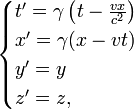So on to special relativity. It has been a while since I took my modern physics course, but luckily Wikipedia, once again, has what I need for a basic review.
Of course, let's start with the all-important Lorentz Factor:
Then the simple Lorentz Transformation for an inertial reference frame moving in the x direction...
Which yeilds time-dialation, and length-contraction in the direction of motion...
Which of-course has the inverse...
We also get the new way to add velocities...
And, we need definitions of Energy and momentum that'll be conserved...
We also need an reference frame invariant way to define "mass"...
If we try to relate the velocity four-vector  to the momentun four-vector
to the momentun four-vector  to get the analogous equation to the non-relativistic
to get the analogous equation to the non-relativistic  we have...
we have...
Which leads to the famous equations...


Giving back our definitions of Energy and momentum. Cool huh?
But that was just a small digression from the straight summary of the basics (i.e. Special Relativity without the formalism)
So what do we have left? Force of course. Which has quite a large number of forms.
We start with the definition that keeps...
...and just crank out from there...
We can split that into components of acceleration, thus...



Well, that should cover the basics...well, there is Kinetic Energy. Real quick...
Let's look at the integral:

This allows us to conclude:
Well, that last bit was ugly, but the result was simple enough.
All this is a bit much for me to digest. But I think I got most of this (excepting maybe exactly knowing when to use inveriant mass, relativistic mass, or rest mass--but I'll figure it out).
After, I digest this stuff, it may be time to move to the formalism.









































